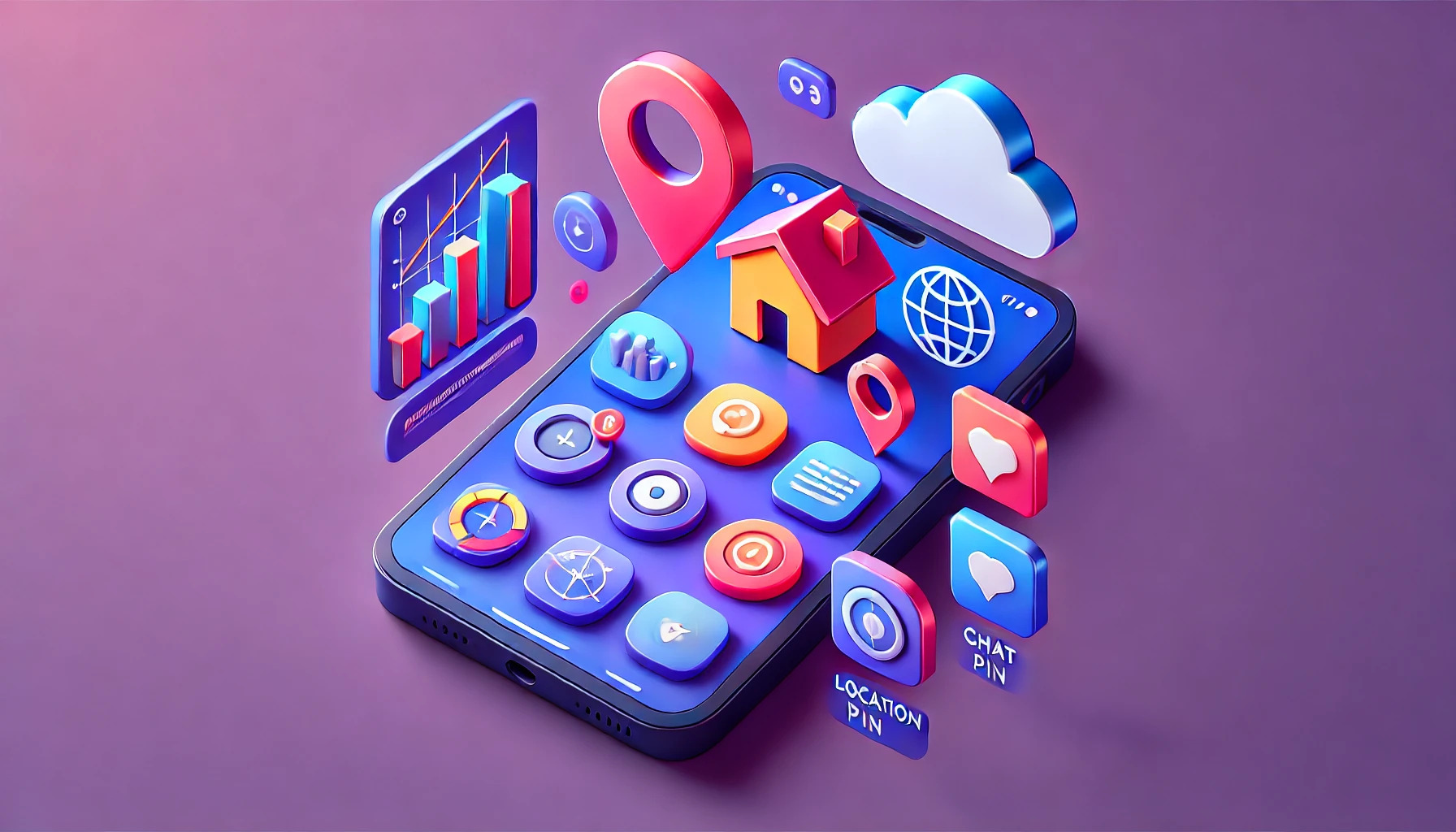In the fast-paced world of information technology, app development has become a crucial component for businesses and organizations. With the increasing variety of mobile platforms and the need to provide a seamless and engaging user experience, choosing the most suitable platform for app development has become even more critical. The article “Mobile Platforms and Their Impact on User Experience” is produced by the Research and Development unit of “Flexinexa” and aims to provide a comprehensive examination of this topic.
Mobile platforms play a fundamental role in the success of an app and the level of user satisfaction it achieves
Mobile platforms play a fundamental role in the success of an app and the level of user satisfaction it achieves. In this article, we analyze and examine the impact of different mobile platforms on user experience and explore key considerations in app development.
Question: How does the choice of a mobile platform affect app development?
The choice of a mobile platform significantly impacts app development in various ways, influencing the entire development lifecycle, user experience, and the overall success of the application. Below are key aspects affected by the choice of mobile platform:
Development Tools and Languages:
- Different platforms require different development tools and programming languages. For instance, iOS development primarily uses Swift or Objective-C with Xcode, while Android development uses Java or Kotlin with Android Studio. This affects the skill set required for the development team and the development environment setup.
User Experience:
- Each platform has its own design guidelines and user experience standards. For example, iOS follows Apple’s Human Interface Guidelines, emphasizing simplicity and consistency, while Android follows Material Design principles, focusing on flexibility and customization. Adhering to these guidelines ensures a native look and feel, enhancing the user experience.
Performance and Optimization:
- The performance of an app can vary based on the platform due to differences in hardware, operating system (Mobile OS), and development practices. Optimizing an app for a specific platform can lead to better performance, faster load times, and smoother interactions.
Market Reach and Audience:
- The choice of platform also determines the potential audience reach. iOS users typically represent a more affluent demographic, while Android has a larger global market share. Deciding on a platform affects the market strategy and the target audience of the app.
Cross-Platform Development:
- If a cross-platform development approach is chosen, frameworks like React Native, Flutter, or Xamarin allow developers to write a single codebase that runs on multiple platforms. However, this might involve trade-offs in terms of performance and access to platform-specific features compared to native development.
Monetization and Revenue Models:
- Different platforms offer varied monetization opportunities and revenue models. For example, iOS users are more likely to make in-app purchases, while Android users contribute significantly to ad revenue. Understanding these dynamics helps in choosing the right monetization strategy.
Security and Compliance:
- Security measures and compliance requirements vary across platforms. iOS is known for its strict app review process and robust security features, while Android’s open nature requires additional considerations for app security and data protection.
Maintenance and Updates:
- The ease of maintaining and updating an app can also be influenced by the platform. iOS updates are typically adopted quickly by users, whereas Android updates are fragmented across different devices and manufacturers, impacting the update strategy.
Mobile platforms enhance user experience through advanced and innovative designs
What are the best practices for optimizing user experience on mobile platforms?
Optimizing user experience (UX) on mobile platforms is crucial for the success of any mobile application. Here are some best practices that can be followed during app development:
Understand User Needs:
- Conduct thorough user research to understand the needs, preferences, and pain points of your target audience. This helps in designing an app that meets user expectations and solves real problems.
Consistent Design Across Platforms:
- For cross-platform development, ensure a consistent design and user experience across different mobile operating systems (Mobile OS). Use common design elements and patterns to create a cohesive experience.
Follow Platform Guidelines:
- Adhere to the design and UX guidelines provided by each platform. For iOS, follow Apple’s Human Interface Guidelines, and for Android, follow Google’s Material Design principles. This ensures that the app feels native to each platform.
Optimize Performance:
- Ensure that the app performs smoothly across different devices and platforms. Optimize load times, minimize battery usage, and ensure that animations and transitions are fluid. Performance optimization is key to retaining users.
Intuitive Navigation:
- Design intuitive navigation that allows users to easily find what they are looking for. Use familiar navigation patterns and ensure that important features are easily accessible.
Responsive Design:
- Ensure that the app is responsive and adapts well to different screen sizes and orientations. This is especially important in cross-platform development to provide a consistent experience on both smartphones and tablets.
Accessibility:
- Make sure your app is accessible to all users, including those with disabilities. Follow accessibility guidelines and test your app with assistive technologies to ensure a wider reach.
Regular Updates:
- Continuously update the app based on user feedback and evolving platform standards. Regular updates help in keeping the app relevant and improve user satisfaction.
Test Extensively:
- Perform extensive testing on multiple devices and platforms. This includes functional testing, usability testing, and performance testing to identify and fix issues before the app is released.
Simplify User Interface:
- Keep the user interface simple and clutter-free. Avoid unnecessary elements and focus on the core functionalities to provide a clean and user-friendly experience.
By incorporating these best practices, app developers can create a mobile app that offers a superior user experience, ensuring user satisfaction and long-term success.

What are the common challenges faced during app development for different mobile platforms?
App development across different mobile platforms presents several challenges that developers must address to ensure a smooth and successful project. Here are some of the common challenges:
Fragmentation:
- Mobile OS Fragmentation: Different versions of mobile operating systems (e.g., various versions of Android and iOS) can lead to fragmentation. Developers need to ensure compatibility with multiple OS versions, which can be time-consuming and complex.
- Device Fragmentation: The wide range of devices with varying screen sizes, resolutions, and hardware capabilities adds another layer of complexity. Ensuring a consistent user experience (UX) across all devices is a significant challenge.
Performance Optimization:
- Cross-Platform Performance: Achieving optimal performance across different platforms can be difficult, especially in cross-platform development. Frameworks like React Native or Flutter help, but they may not always match the performance of native development.
- Resource Management: Efficiently managing resources such as memory and battery life across different platforms is crucial. Poor resource management can lead to slow app performance and drain the device’s battery quickly.
User Experience (UX):
- Consistent UX: Creating a consistent user experience across different platforms while adhering to each platform’s design guidelines (e.g., Apple’s Human Interface Guidelines for iOS and Material Design for Android) can be challenging. Balancing platform-specific elements with a unified UX strategy requires careful planning and execution.
Security:
- Platform-Specific Security: Each mobile platform has its own security protocols and best practices. Developers need to implement robust security measures tailored to each platform, which can be challenging and requires in-depth knowledge of platform-specific security features.
- Data Protection: Ensuring the security and privacy of user data across different platforms involves adhering to various regulations and implementing secure data storage and transmission methods.
Testing and Debugging:
- Comprehensive Testing: Testing the app on a wide variety of devices and OS versions is essential to identify and fix issues. This process can be time-consuming and requires extensive resources.
- Platform-Specific Bugs: Bugs and issues that appear on one platform may not exist on another, making debugging a more complex and fragmented process.
Development and Maintenance Costs:
- Increased Costs: Developing and maintaining apps for multiple platforms can significantly increase costs. This includes the cost of development tools, testing devices, and the need for specialized skills for each platform.
- Regular Updates: Keeping the app updated with the latest OS versions and device specifications requires continuous effort and resources.
Integration with Platform-Specific Features:
- Feature Parity: Ensuring that the app integrates seamlessly with platform-specific features (e.g., Siri for iOS or Google Assistant for Android) while maintaining feature parity across platforms can be challenging.
User Expectations:
- Meeting User Expectations: Users on different platforms may have different expectations regarding app functionality and performance. Balancing these expectations while delivering a high-quality app experience on all platforms is crucial.
By understanding and addressing these challenges, developers can create robust, high-performing, and user-friendly apps that cater to the needs of users across different mobile platforms
The choice of the appropriate mobile platform and adherence to best practices in app development significantly enhances user experience and contributes to the long-term success of an application. The Research and Development unit at “Flexinexa” has conducted a comprehensive and thorough examination of this subject, providing valuable insights and solutions for developers to create high-performing and user-friendly apps.
Developers must deeply understand the needs and preferences of users and leverage cross-platform development and performance optimization methods to create apps that not only meet current user requirements but also adapt to future trends. This approach ensures user satisfaction and success in today’s competitive landscape.
(FAQ)
- What are mobile platforms and why is choosing the right platform important?
Answer: Mobile platforms include operating systems like iOS and Android that run on mobile devices. Choosing the right platform is crucial in app development because each platform has its own features, tools, and programming languages that can impact the app’s performance and user experience.
- How does the choice of a mobile platform affect user experience (UX)?
Answer: Each mobile platform has its own design guidelines and user experience standards. Following these guidelines helps create a seamless and satisfying user experience. The right platform choice can enhance the app’s performance, speed, and smooth interactions.
- What are the benefits of cross-platform development?
Answer: Cross-platform development allows developers to create apps for multiple platforms using a single codebase. This approach saves time and costs, and helps maintain consistent user experience across different platforms.
- What are the common challenges faced during app development for different mobile platforms?
Answer: Common challenges in app development for different platforms include OS fragmentation, performance optimization, integration with platform-specific features, and resource management. Developers need to ensure the app works well across all devices and OS versions.
- How can user experience (UX) be improved in mobile apps?
Answer: To improve user experience in mobile apps, developers should focus on intuitive and simple design, performance optimization, compatibility with various screen sizes, and adherence to platform design guidelines. Extensive and continuous testing on different devices is also essential.
- What are the differences between iOS and Android operating systems?
Answer: iOS and Android are both popular mobile operating systems, but they differ in design, development tools, programming languages, and target markets. iOS is known for its high security and compatibility within Apple devices, while Android is favored for its flexibility and global market reach.
- How can app performance be optimized across different platforms?
Answer: Optimizing app performance requires efficient resource management, reducing load times, and ensuring smooth animations and transitions. Using performance optimization tools and frameworks specific to each platform can also help improve performance.
- How can the security of mobile apps be ensured?
Answer: Each mobile platform has its own security protocols and best practices. Developers should utilize the native security features of each platform and implement secure data storage and transmission methods. Compliance with various regulations is also essential.
- What factors should be considered when choosing a platform for app development?
Answer: Factors to consider when choosing a platform for app development include target market needs, device features, available development tools and programming languages, development and maintenance costs, and monetization opportunities.
- How can cross-platform development methods be leveraged?
Answer: To leverage cross-platform development methods, developers can use frameworks like React Native, Flutter, or Xamarin. These frameworks enable the creation of apps with a shared codebase that can run on multiple platforms, simplifying development and maintenance processes.
















